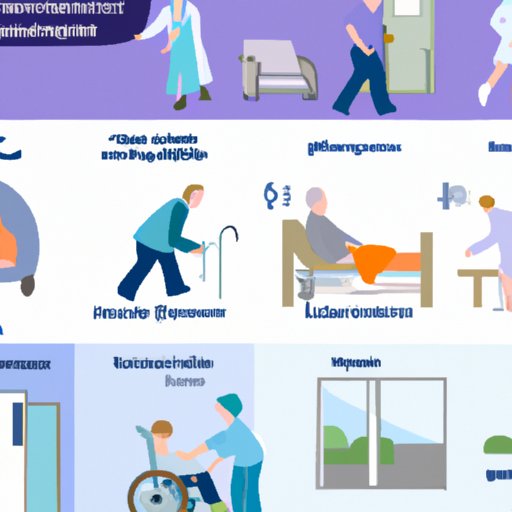Introduction
Adverse events in home health care refer to any incident that results in harm or injury to patients receiving care in their homes. These events can range from minor injuries to life-threatening complications, making it essential for providers and caregivers to understand the causes, consequences, and strategies for preventing and managing them.
The prevalence of adverse events in home health care is increasing as more people opt to receive care in their own homes. In addition to providing greater convenience, this setting has also been found to be cost-effective. However, it also presents unique challenges, such as difficulty monitoring patients, inadequate training and education of caregivers, and lack of access to resources. As a result, it is important to take proactive steps to ensure the safety of patients receiving care at home.
The purpose of this article is to explore the causes and consequences of adverse events in home health care. It will provide an overview of common types of adverse events, strategies for prevention and management, a comprehensive guide to recognizing and responding to them, and risks associated with home health care. Finally, it will explore potential solutions to minimize the occurrence of these events.

Investigating the Causes and Consequences of Adverse Events in Home Health Care
Adverse events in home health care can occur due to a variety of factors, including medication errors, falls, infections, and other types of preventable incidents. Common contributing factors include inadequate communication among providers, lack of patient education, inadequate training and supervision of staff, and lack of resources.
The consequences of adverse events in home health care can be serious and long-term. In some cases, they may lead to physical injury, illness, and even death. They can also have psychological and emotional effects, such as fear, anxiety, and depression. In addition, they can cause financial repercussions, such as increased medical costs and lost wages.

An Overview of Common Adverse Events in Home Health Care
Adverse events in home health care can range from minor injuries to life-threatening complications. The most common types of adverse events include medication errors, falls, and infections.
Medication Errors
Medication errors are one of the most common types of adverse events in home health care. These errors can occur due to a variety of factors, such as incorrect dosage, wrong route of administration, improper timing, or drug interactions. They can also occur due to inadequate communication between providers, lack of patient education, and lack of resources.
Falls
Falls are another common type of adverse event in home health care. They can occur due to a variety of factors, such as slippery surfaces, objects in the way, poor lighting, and inadequate supervision. They can also occur due to underlying medical conditions, such as balance issues or impaired vision.
Infections
Infections are another common type of adverse event in home health care. They can occur due to a variety of factors, such as lack of hand hygiene, inadequate cleaning of equipment, and improper disposal of needles or other sharps. They can also occur due to underlying medical conditions, such as weakened immune systems.
Other Types of Adverse Events
In addition to medication errors, falls, and infections, there are other types of adverse events in home health care. These include pressure ulcers, burns, lacerations, allergic reactions, and respiratory distress.
Strategies for Preventing and Managing Adverse Events in Home Health Care
There are several strategies that can be used to prevent and manage adverse events in home health care. These include establishing clear guidelines and protocols, utilizing technology to monitor care, providing education and training, and regularly assessing patients.
Establish Clear Guidelines and Protocols
It is important to establish clear guidelines and protocols for providing care at home. This includes ensuring that all staff members are properly trained and educated on how to provide safe and effective care. It also includes establishing systems to monitor and evaluate care, such as documenting patient progress and implementing quality assurance measures.
Utilize Technology to Monitor Care
Technology can be used to monitor care in the home setting. This includes using remote monitoring devices, such as sensors and cameras, to track patient health and activity. It also includes utilizing electronic health records to track changes in patient condition over time.
Provide Education and Training
It is also important to provide education and training to staff and caregivers. This includes educating them on proper techniques for providing care, as well as teaching them how to recognize and respond to signs of adverse events. It also includes providing them with resources, such as patient handouts, to help them better understand the needs of their patients.
Regularly Assess Patients
Finally, it is important to regularly assess patients to identify any changes in their condition. This includes conducting physical assessments, such as checking vital signs, as well as evaluating their overall mental and emotional state. It also includes monitoring for any signs of adverse events, such as falls or medication errors.
A Comprehensive Guide to Recognizing and Responding to Adverse Events in Home Health Care
Recognizing and responding to adverse events in home health care is essential for providing safe and effective care. Below is a comprehensive guide to recognizing and responding to these events:
Signs and Symptoms of Adverse Events
It is important to be aware of the signs and symptoms of adverse events in home health care. These can include changes in vital signs, sudden changes in behavior or mood, pain or discomfort, and unusual skin discoloration. It is also important to be alert for any signs of infection, such as fever, chills, or diarrhea.
Appropriate Response to Adverse Events
When an adverse event occurs, it is important to take appropriate action. This includes notifying the primary care provider, administering first aid, and taking steps to prevent further injury or harm. It is also important to document the incident, as this can help identify any patterns or trends in adverse events.
Understanding the Risks Associated with Home Health Care and Adverse Events
Adverse events in home health care can pose a risk to both patients and providers. For patients, these risks can include physical injury, illness, and even death. They can also experience psychological and emotional effects, such as fear, anxiety, and depression. For providers, these risks can include legal liability, loss of license, and professional censure.

Exploring Solutions to Minimize the Occurrence of Adverse Events in Home Health Care
To minimize the occurrence of adverse events in home health care, it is important to take proactive steps. These include improving quality control measures, increasing collaboration among providers, and enhancing patient and family involvement. It is also important to provide education and training to staff and caregivers, as well as utilize technology to monitor care.
Conclusion
Adverse events in home health care can lead to serious and long-term consequences. It is important to understand the causes, consequences, and strategies for preventing and managing these events. This article provided an overview of common types of adverse events, strategies for prevention and management, a comprehensive guide to recognizing and responding to them, and risks associated with home health care. Finally, it explored potential solutions to minimize the occurrence of these events.
In conclusion, it is essential for providers and caregivers to understand the causes, consequences, and strategies for preventing and managing adverse events in home health care. It is also important to take proactive steps to ensure the safety of patients receiving care at home. By doing so, providers and caregivers can help reduce the risk of adverse events and ensure optimal care for their patients.
(Note: Is this article not meeting your expectations? Do you have knowledge or insights to share? Unlock new opportunities and expand your reach by joining our authors team. Click Registration to join us and share your expertise with our readers.)
